Overview
Elms are deciduous and semi-deciduous trees comprising the flowering plant genus Ulmus in the family Ulmaceae. The elm tree grows to great heights, often with a forked trunk creating a vase profile. Generally, Elm leaves are alternated with simple, single or most commonly double serrated margins, usually asymmetric at the base and acuminate at the apex.
The tree also consists of patalless flowers that appear before the leaves and are borne in clusters on jointed stems. Elm’s nutlike fruit is surrounded by a flat, sometimes hairy, wing-like structure referred to as Samara. All types of elms are tolerant of a wide range of soils and PH levels but, with few exceptions, demand good drainage. These trees have flourished and spread over most of the North Hemisphere, inhibiting the temperate and subtropical regions of North America and Eurasia.
Types Of Elm Trees
1. American Elm Tree
The American elm is a small to medium-sized (to very large) tree, at maturity with spreading branches forming a broad-spreading, fan-shaped crown. The twigs are slender, reddish-brown turning as gray with age, hairy at first and smooth later. The bark of American elm is gray, in cross-section with alternating brown and white layers, grooves deep, ridges flattened with thin closely pressed scales.

Plant Profile
- Botanical Name: Ulmus americana
- Other Common Name: Water elm, swamp elm, Florida elm, soft elm, gray elm
- Native: Eastern North America, naturally occurring from Nova Scotia, Florida and central Texas
- Shape: Vase-shaped
- Hardiness Zones: 2-9
- Soil preference: Moist, well-drained soil
- Size: More than 80 feet
- Leaves: Alternate with double-serrate margins and an oblique base.
- Bark: Dark gray, ridged bark
- Fruit: Flat is flat with papery wing surrounding the single seed
- Light Requirement: Full sun (at least 6 hours of daily sun)
- Growth rate: Fast, Moderate
- Landscape Use: Specimen, shade tree, Parkway/street
- Tolerances: Dry sites, Alkaline soil, Clay soil, Salty soil
- Season Of Interest: Early winter, midwinter, late winter, early fall, mid fall
- Diseases & Pests: Dutch elm disease, elm yellows, elm phloem necrosis, elm bark beetle, elm leaf beetles, elm leaf miner and verticillium wilt.
2. Japanese Elm Tree ( Zelkova serrata)
Zelkova serrata is a medium sized tree usually growing to 30 m tall. It has alternately arranged leaves that are ovate to oblong-ovate in shape with serrated or crenate margins. To effectively identify Zelkova serrata, a short main trunk, low branching and a vase-shaped habit are main characteristics. The twigs of this plant are slender with small, dark conical buds in a zigzag pattern. The branches are usually glabrous. The bark is grayish white to grayish brown and either smooth with lenticels or exfoliating in patches to reveal orange inner bark. The branchlets are brownish-purple to brown.
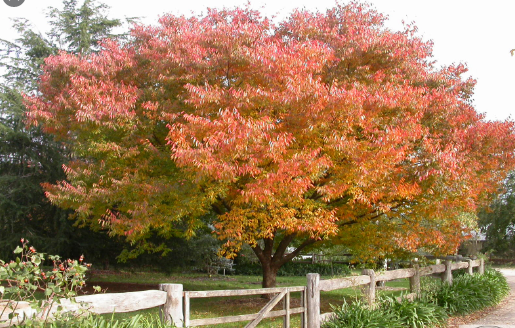
Plant Profile
- Botanical Name: Ulmus japonica or Ulmus propinqua, Zelkova serrata
- Other Common Nam: Japanese Elm Tree
- Native: Japan and Northeastern Asia
- Shape: Rounded, Spreading or Vase Shape
- Soil preference: Moist, well-drained soil (Clay, loam or sand texture)
- Size: 35-55 feet high
- Leaves: Alternately arranged, simple and ovate to oblong-ovate with serrated or crenated margins
- Bark: Dark brown or dark gray, exfoliating furrowed or ridged.
- Fruit: Small, ovate, wingless drupes that ripen in late summer to autumn
- Light Requirement: Full sun (at least 6 hours of daily sun)
- Growth rate: Fast, Moderate
- Landscape Use: Specimen, shade tree, Parkway/street
- Tolerances: Dry sites, Alkaline soil, Clay soil, Salty soil
- Season Of Interest: Early winter, midwinter, late winter, early fall, mid fall
- Sexuality: Monoecious
- Flower Color: Yellow-green
- Diseases & Pests: Dutch elm disease, elm yellows, elm phloem necrosis, elm bark beetle, elm leaf beetles, elm leaf miner and verticillium wilt.
3. Rock Elm (Ulmus thomasii)
Rock elm is a rare tree that can grow up 100 ft and may live for up to 300 years. The leaves are shiny dark green on the upper side and light green on the underside. The larger twigs have corky, irregular, prominent ridges. The brown buds are broadly rounded and velvety. The characteristic corky ridges are present on the small trunks and branches and on larger trunks; the bark is broken into narrow, interlacing ridges. The wafer-like fruit is winged, contain one seed and is similar to the fruit of other elms but is narrower and velvety.

Plant Profile
- Botanical Name: Ulmus thomasii
- Family: Ulmaceae
- Other Common Nam: The rock elm or cork elm
- Native: Midwestern United States
- Shape: Rounded, Spreading or Vase Shape
- Soil preference: Moist, well-drained soil (Clay, loam or sand texture)
- Size: 50-100 feet high
- Leaves: Wide, oval to obovate with a round, symmetrical base and acuminate apex.
- Bark: Grey-brown and deeply furrowed into scaly, flattened ridges
- Fruit: Broad ovate samara covered with fine hair notched at the tip
- Light Requirement: Full sun (at least 6 hours of daily sun)
- Growth rate: Fast, Moderate
- Landscape Use: Specimen, shade tree, Parkway/street
- Tolerances: Dry sites, Alkaline soil, Clay soil, Salty soil
- Season Of Interest: Early winter, midwinter, late winter, early fall, mid fall
- Diseases & Pests: Dutch elm disease, elm yellows, elm phloem necrosis, elm bark beetle, elm leaf beetles, elm leaf miner and verticillium wilt.
Also Read: Different of Spruce Tree For Your Yard
4. Camperdown Elm Tree
Camperdown elm is native to the forest at camperdown House, in Dundee, Scotland. The tree slowly develops a broad, flat head that may eventually build as high as 4 m and a commensurately wide crown with a weeping habit. The trunk of the young trees is smooth and silver-grey; later it turns dark grey with a network of grooves on maturity. Young twigs are brown, slightly hairy and have lenticels whereas the leaves are hairy on both sides and roughly serrated.
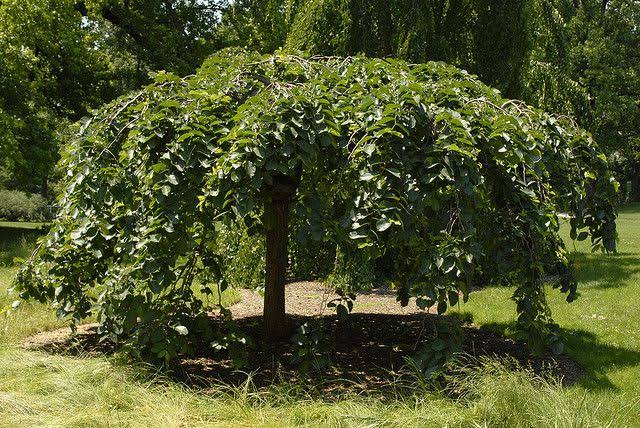
Plant Profile
- Botanical Name: Ulmus glabra ‘camperdownii’
- Family: Ulmaceae
- Other Common Nam: Camperdown elm
- Native: Camperdown, Dundee, Scotland
- Shape: Rounded, Spreading or Vase Shape
- Soil preference: Moist, well-drained soil (Clay, loam or sand texture)
- Size: 25 feet high
- Leaves: Broad obovate, hairy on both sides and roughly serrated; the upper feels rough
- Bark: Grey-brown and deeply furrowed into scaly, flattened ridges
- Fruit: flat winged nutlets, round to elliptical, brown
- Crown: Broad weeping, dark, dense
- Light Requirement: Full sun (at least 6 hours of daily sun)
- Growth rate: Fast, Moderate
- Landscape Use: Specimen, shade tree, Parkway/street
- Tolerances: Dry sites, Alkaline soil, Clay soil, Salty soil
- Season Of Interest: March and April
- Hardiness Zones: 4 to 7
- Diseases & Pests: Dutch elm disease, elm yellows, elm phloem necrosis, elm bark beetle, elm leaf beetles, elm leaf miner and verticillium wilt.
5. Cherry Bark Elm Tree (Ulmus villosa Brandis ex Gamble)
Ulmus villosaalso referred to as Cherry Bark elm is a long lived deciduous tree native to the North West and western Himalaya. Its mid green leaves are elliptic with serrated margins, and turns yellow before they fall in autumn. Its branches are slightly pendulous. Its grey bark is smooth with distinctive cherry like bands when young, fissuring with age. Its hermaphrodite flowers are without petals and are wind pollinated. Its fruits are in the form of sumara, elliptic and up to 12 cm long.
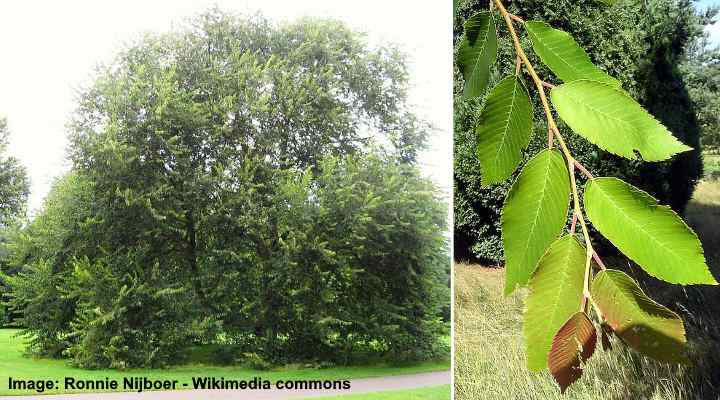
Plant Profile
- Botanical Name: Ulmus villosa
- Family: Ulmaceae
- Other Common Nam: Cherry Bark Elm Tree
- Native: West and Western Himalaya
- Shape: Rounded, Spreading or Vase Shape
- Soil preference: Moist, well-drained soil (Clay, loam or sand texture)
- Size: Up to 25 m high
- Leaves: Oblong-elliptic with serrated margins
- Bark: Smooth with distinctive horizontal bands of lenticels when young, fissuring with age
- Fruit: flat winged nutlets, round to elliptical, brown
- Crown: Broad weeping, dark, dense
- Light Requirement: Full sun (at least 6 hours of daily sun)
- Growth rate: Fast, Moderate
- Landscape Use: Specimen, shade tree, Parkway/street
- Tolerances: Dry sites, Alkaline soil, Clay soil, Salty soil
- Season Of Interest: Spring
- Hardiness Zones: 2 to 7
- Diseases & Pests: Dutch elm disease, elm yellows, elm phloem necrosis, elm bark beetle, elm leaf beetles, elm leaf miner and verticillium wilt.
6. Slippery ElmTree (Ulmus rubra)
Ulmus rubra also referred to as the slippery elm is native to eastern North America, ranging from southeast North Dakota, east to Maine and south Quebec, south to northern Florida and western Texas where it thrives in moist uplands although it can also grow in dry, intermediate soils. This species is almost similar to the American elm, however, it is mainly distinguished from the American elm by its downy twigs, chestnut brown or reddish hairy buds and slimy red inner bark.
The leaves of this plant are broad oblong to obovate, rough above but velvety below with coarse double-serrated margins, acuminate apices and oblique bases. The leaves are often red tinged on emergence, turning dark green by summer and then a dull yellow in the fall.

Plant Profile
- Botanical Name: Ulmus rubra
- Family: Ulmaceae
- Other Common Nam: Slippery Elm Tree, Red elm, Indian elm, Moose elm
- Native: Eastern North America, ranging from Southeast North Dakota, east to Main, Florida and Texas
- Shape: Spreading
- Soil preference: Moist, well-drained soil (Clay, loam or sand texture)
- Size: 12-19 m high
- Leaves: Long, broad and oblong to obovate. Often red tinged on emergence, turning dark green by summer and then yellow in the fall.
- Bark: Slimy red inner bark
- Fruit: Reddish-brow, oval winged samara, orbicular to obovate, slightly notched at the top
- Light Requirement: Full sun (at least 6 hours of daily sun)
- Growth rate: Fast, Moderate
- Landscape Use: Specimen, shade tree, Parkway/street
- Tolerances: Dry sites, Alkaline soil, Clay soil, Salty soil
- Season Of Interest: Spring
- Hardiness Zones: 2 to 9
- Diseases & Pests: Dutch elm disease, elm yellows, elm phloem necrosis, elm bark beetle, elm leaf beetles, elm leaf miner and verticillium wilt.
Also Read: Different Types of Birch Trees For Landscaping
7. Cedar Elm Tree (Ulmus crassifolia Nutt)
Ulmus crassifolia also referred to as Texas cedar elm or simply cedar elm is a medium to large deciduous tree, native to south central North America, mainly in southern and eastern Texas, Southern Oklahoma, Arkansas and Louisiana. The tree grows to 24-27 m tall with a rounded crown. The leaves are small with an oblique base. The bark is light brown to gray, with flattened ridges that break into thin, loose, flaky scales. The fruit is a small winged samara, maturing quickly after the flowering in late fall.

Plant Profile
- Botanical Name: Ulmus crassifolia
- Family: Ulmaceae
- Other Common Nam: Texas cedar elm, cedar elm
- Native: South and eastern Texas
- Shape: Spreading
- Soil preference: Moist, well-drained soil (Clay, loam or sand texture)
- Size: 30-75 feet high
- Leaves: Alternate, oval to elliptical in shape, finely-toothed or sometimes double-toothed along the margin and blunt at the tip.
- Bark: Light brown to gray, with flattened ridges that break into thin, loose, flaky scales.
- Fruit: Reddish-brow, oval winged samara, orbicular to obovate, slightly notched at the top
- Light Requirement: Full sun (at least 6 hours of daily sun)
- Growth rate: Fast, Moderate
- Landscape Use: Specimen, shade tree, Parkway/street
- Tolerances: Dry sites, Alkaline soil, Clay soil, Salty soil
- Season Of Interest: Spring
- Hardiness Zones: 2 to 9
- Diseases & Pests: Dutch elm disease, elm yellows, elm phloem necrosis, elm bark beetle, elm leaf beetles, elm leaf miner and verticillium wilt.
8. David Elm Tree (Ulmus davidiana Planch)
Ulmus davidiana also referred to as David elm tree or Father David is a large to medium deciduous tree with a remarkable resemblance to the American elm. It is widely distributed across China, Mongolia, Korea, Siberia and Japan. The leaves of this plant are rough on the upper surface and often dark red on emergence with an obovate to obovate-elliptic shape. The tree grows to a maximum of 15m (50 ft) with a relatively slender trunk supporting a dense canopy casting a heavy shade. Its bark remains smooth for comparatively long time, before becoming longitudinally fissured.

Plant Profile
- Botanical Name: Ulmus davidiana
- Family: Ulmaceae
- Other Common Nam: Father David elm
- Native: Asia, Europe and United States
- Shape: Spreading
- Soil preference: Moist, well-drained soil (Clay, loam or sand texture)
- Size: 15 m high
- Leaves: Often dark red on emergence and are obovate to obovate-elliptic
- Bark: Smooth and longitudinally fissured
- Fruit: Reddish-brow, oval winged samara, orbicular to obovate, slightly notched at the top
- Light Requirement: Full sun (at least 6 hours of daily sun)
- Growth rate: Fast, Moderate
- Landscape Use: Specimen, shade tree, Parkway/street
- Tolerances: Dry sites, Alkaline soil, Clay soil, Salty soil
- Season Of Interest: Spring
- Hardiness Zones: 2 to 9
- Diseases & Pests: Dutch elm disease, elm yellows, elm phloem necrosis, elm bark beetle, elm leaf beetles, elm leaf miner and verticillium wilt.
Also Read: Different Types of Softwood Trees
9. Siberian Elm (Ulmus pumila)
Ulmus pumila, also referred to as Siberian elm is usually a small to medium-sized, often bushy, deciduous tree growing to 25 m tall. It is native to Central Asia, eastern Siberian, the Russian Far East, Mongolia, Tibet, northern China, India and Korea. The leaf blade is elliptic-ovate to elliptic-lanceolate, changing from dark green to yellow in autumn. The branchlets are yellowish gray, glabrous, unwinged and without a cork layer, with scattered lenticels. The bark is dark gray, irregularly longitudinally fissured.

Plant Profile
- Botanical Name: Ulmus pumila
- Family: Ulmaceae
- Other Common Nam: Siberian Elm, Asiatic elm or Dwarf elm
- Native: Asia, Russian Far East
- Shape: Spreading
- Soil preference: Moist, well-drained soil (Clay, loam or sand texture)
- Size: 15 m high
- Leaves: The leaf blade elliptic-ovate to elliptic-lanceolate, the color changing from dark green to yellow in autumn
- Bark: Dark gray, irregularly longitudinally fissured
- Fruit: Reddish-brow, oval winged samara, orbicular to obovate, slightly notched at the top
- Light Requirement: Full sun (at least 6 hours of daily sun)
- Growth rate: Fast, Moderate
- Landscape Use: Specimen, shade tree, Parkway/street
- Tolerances: Dry sites, Alkaline soil, Clay soil, Salty soil
- Season Of Interest: Spring
- Hardiness Zones: 2 to 9
- Diseases & Pests: Dutch elm disease, elm yellows, elm phloem necrosis, elm bark beetle, elm leaf beetles, elm leaf miner and verticillium wilt.
10. Chinese Elm Tree (Ulmus parvifolia)
Ulmus parvifolia commonly referred to as the Chinese elm or lacebark elm is a small to medium tree growing to 10-18 m tall with a slender trunk and crown. The tree is native to eastern Asia, including China, Taiwan, Japan, North Korea, South Korea and Vietnam. The leaves of this tree are small, leathery, lustrous green and single-toothed whereas its fruit is a samara, elliptic to ovate-elliptic and matures rapidly. The trunk has flaking bark of mottled grays with tans and reds, giving rise to its other popular name, the lacebark elm.

Plant Profile
- Botanical Name: Ulmus parvifolia
- Family: Ulmaceae
- Other Common Names: Chinese elm or lacebark elm
- Native: Eastern Asia, including China, Taiwan, Japan, North Korea, South Korea and Vietnam
- Shape: Spreading
- Soil preference: Moist, well-drained soil (Clay, loam or sand texture)
- Size: 10-18 m high
- Leaves: Leathery, lustrous green single-toothed leaves
- Bark: Flaking with molten grays with tan and reds
- Fruit: Samara, elliptic to ovate-elliptic
- Light Requirement: Full sun (at least 6 hours of daily sun)
- Growth rate: Fast, Moderate
- Landscape Use: Specimen, shade tree, Parkway/street
- Tolerances: Dry sites, Alkaline soil, Clay soil, Salty soil
- Season Of Interest: Spring
- Hardiness Zones: 2 to 9
- Diseases & Pests: Dutch elm disease, elm yellows, elm phloem necrosis, elm bark beetle, elm leaf beetles, elm leaf miner and verticillium wilt.
Also Read: Different Types of Cypress Trees For Landscaping
11. English Elm (Ulmus minor)
The Field elm commonly referred to as English elm is a large to medium tree, often exceeding 40 m in height. The upper branches of this tree form a fan-shaped crown with dark green leaves. Small reddish-purple hermaphrodite apetalous flowers appear in early spring before the leaves. English elms have rough, deeply furrowed bark that looks like blocks on the tree trunk.
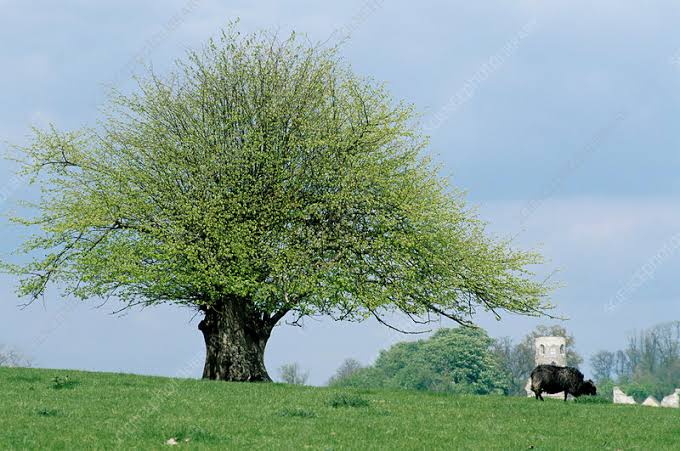
Plant Profile
- Botanical Name: Ulmus minor
- Family: Ulmaceae
- Other Common Names: Common elm, horse may, Atinian elm, field elm
- Native: Eastern Asia, including China, Taiwan, Japan, North Korea, South Korea and Vietnam
- Shape: Spreading
- Soil preference: Moist, well-drained soil (Clay, loam or sand texture)
- Size: 20-30 m high
- Leaves: Leaves are dark green, almost orbicular, long, without the pronounced acuminate tip at the apex typical of the genus.
- Bark: Scarly
- Fruit: Samara, elliptic to ovate-elliptic
- Light Requirement: Full sun (at least 6 hours of daily sun)
- Growth rate: Fast, Moderate
- Landscape Use: Specimen, shade tree, Parkway
- Tolerances: Dry sites, Alkaline soil, Clay soil, Salty soil
- Season Of Interest: Spring
- Hardiness Zones: 2 to 9
- Diseases & Pests: Dutch elm disease, elm yellows, elm phloem necrosis, elm bark beetle, elm leaf beetles, elm leaf miner and verticillium wilt.
12. European White Elm (Ulmus laevis)
Ulmus laevis also referred to as European white elm, fluttering, spreading elm, stately elm or the Russian elm is a large tree native to Europe, from Northeast France to Southern Finland. The leaves of this tree are alternate, comparatively thin, often papery in texture and very translucent, smooth above with a downy underside.
The tree is rather less symmetrical with a looser, untidy branch structure and less neatly rounded crown. The bark is smooth at first, then in early maturity breaks into thin grey scales, which separate with age into a network of grey-brown scales and reddish-brown under-bark and finally is deeply fissured in old age like other elms.

Plant Profile
- Botanical Name: Ulmus laevis
- Family: Ulmaceae
- Other Common Names: European white elm, fluttering elm, spreading elm, stately elm
- Native: Europe (France, Finland)
- Shape: Spreading
- Soil preference: Moist, well-drained soil (Clay, loam or sand texture)
- Size: 20-30 m high
- Leaves: The leaves of this tree are alternate, comparatively thin, often papery in texture and very translucent
- Bark: The bark is smooth at first, then in early maturity breaks into thin grey scales
- Fruit: Samara, elliptic to ovate-elliptic
- Light Requirement: Full sun (at least 6 hours of daily sun)
- Growth rate: Fast, Moderate
- Landscape Use: Specimen, shade tree, Parkway
- Tolerances: Dry sites, Alkaline soil, Clay soil, Salty soil
- Season Of Interest: Spring
- Hardiness Zones: 2 to 9
- Diseases & Pests: Dutch elm disease, elm yellows, elm phloem necrosis, elm bark beetle, elm leaf beetles, elm leaf miner and verticillium wilt.
Also Read: Different Types of Walnut Trees For Your Home
13. Wych elm Tree (Ulmus glabra)
Wych elm tree also referred to as Scots elm is a large to medium tree that reaches heights of 40 m, typically with a broad crown. This type of elm is known for its tough, supple young shoots, which are always without the corky ridges, characteristic of many elms. The leaves are broad usually obovate with asymmetric base with the lobe often completely covering the short petiole. The fruit of this tree is a winged samara with a single round, seed in the centre, maturing in late spring.

Plant Profile
- Botanical Name: Ulmus glabra
- Family: Ulmaceae
- Other Common Names: Scotch elm, Scots elm or Wych elm
- Native: Europe
- Shape: Spreading
- Soil preference: Moist, well-drained soil (Clay, loam or sand texture)
- Size: 20-30 m high
- Leaves: The leaves are broad usually obovate with asymmetric base with the lobe often completely covering the short petiole.
- Bark: Gray-black
- Fruit: Samara, elliptic to ovate-elliptic
- Light Requirement: Full sun (at least 6 hours of daily sun)
- Growth rate: Fast, Moderate
- Landscape Use: Specimen, shade tree, Parkway
- Tolerances: Dry sites, Alkaline soil, Clay soil, Salty soil
- Season Of Interest: Spring
- Hardiness Zones: 2 to 9
- Diseases & Pests: Dutch elm disease, elm yellows, elm phloem necrosis, elm bark beetle, elm leaf beetles, elm leaf miner and verticillium wilt.
14. Dutch elm (Ulmus hollandica)
Ulmus hollandica often simply referred to as Dutch elm, is a natural hybrid between Wych elm and field elm. The leaves of Dutch elm are slender egg-shaped with a long tip and double serrated margin whereas the bark is gray-black, first smooth and later fissured lengthwise. Its yellowish flowers are short stalked and inconspicuous. The fruits of Dutch elm are samaras, elliptical with broad wings. The young twigs are hairy and red-brown. The buds are brown, ovate, hairy and protruding.
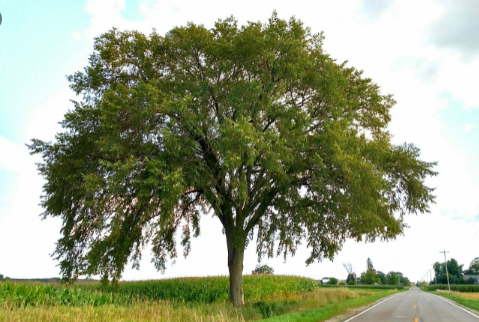
Plant Profile
- Botanical Name: Ulmus hollandica
- Family: Ulmaceae
- Other Common Names: Dutch elm
- Native: Holland
- Shape: Spreading
- Soil preference: Moist, well-drained soil (Clay, loam or sand texture)
- Size: 20-40 m high
- Leaves: Slender, egg-shaped with a long tip, have an asymmetrical leaf base and are long with a short petiole. The leaf margin is double serrated.
- Bark: Gray-black, first smooth and later fissured lengthwise
- Fruit: Samara, elliptic to ovate-elliptic
- Light Requirement: Full sun (at least 6 hours of daily sun)
- Growth rate: Fast, Moderate
- Landscape Use: Specimen, shade tree, Parkway
- Tolerances: Dry sites, Alkaline soil, Clay soil, Salty soil
- Season Of Interest: Spring
- Hardiness Zones: 2 to 9
- Diseases & Pests: Dutch elm disease, elm yellows, elm phloem necrosis, elm bark beetle, elm leaf beetles, elm leaf miner and verticillium wilt.